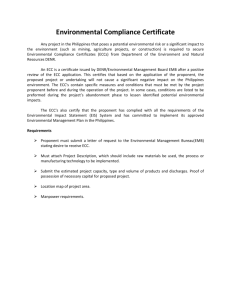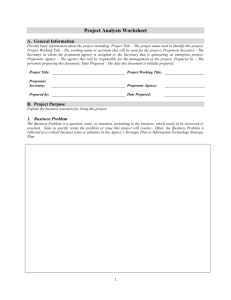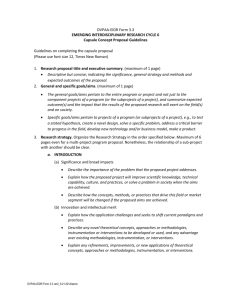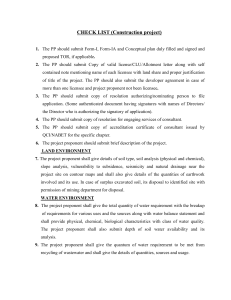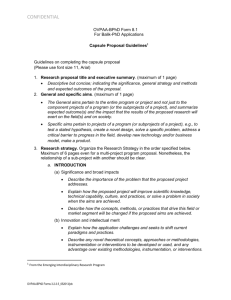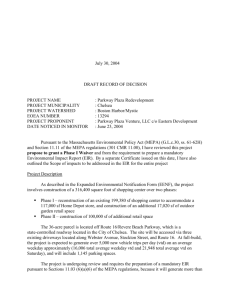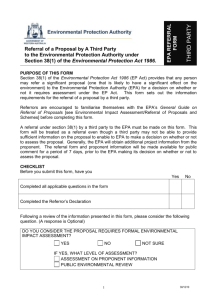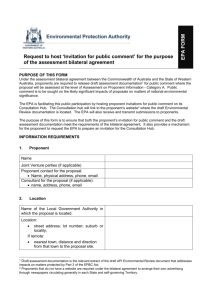A Professional Engineer must seal staged traffic control drawings
advertisement
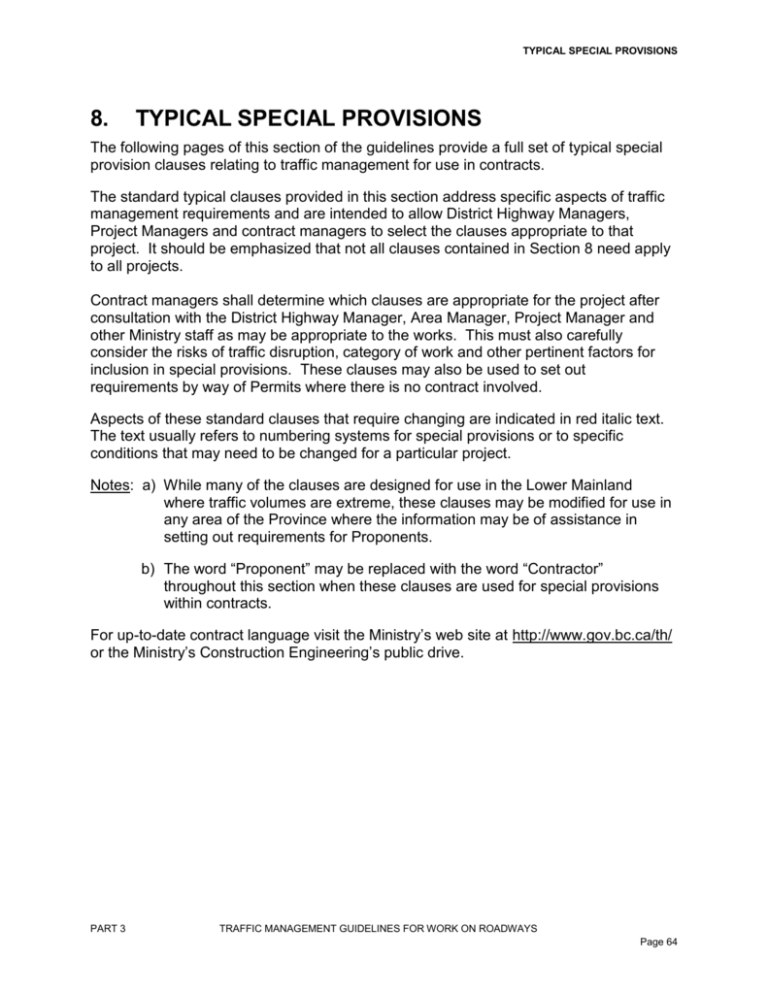
TYPICAL SPECIAL PROVISIONS 8. TYPICAL SPECIAL PROVISIONS The following pages of this section of the guidelines provide a full set of typical special provision clauses relating to traffic management for use in contracts. The standard typical clauses provided in this section address specific aspects of traffic management requirements and are intended to allow District Highway Managers, Project Managers and contract managers to select the clauses appropriate to that project. It should be emphasized that not all clauses contained in Section 8 need apply to all projects. Contract managers shall determine which clauses are appropriate for the project after consultation with the District Highway Manager, Area Manager, Project Manager and other Ministry staff as may be appropriate to the works. This must also carefully consider the risks of traffic disruption, category of work and other pertinent factors for inclusion in special provisions. These clauses may also be used to set out requirements by way of Permits where there is no contract involved. Aspects of these standard clauses that require changing are indicated in red italic text. The text usually refers to numbering systems for special provisions or to specific conditions that may need to be changed for a particular project. Notes: a) While many of the clauses are designed for use in the Lower Mainland where traffic volumes are extreme, these clauses may be modified for use in any area of the Province where the information may be of assistance in setting out requirements for Proponents. b) The word “Proponent” may be replaced with the word “Contractor” throughout this section when these clauses are used for special provisions within contracts. For up-to-date contract language visit the Ministry’s web site at http://www.gov.bc.ca/th/ or the Ministry’s Construction Engineering’s public drive. PART 3 TRAFFIC MANAGEMENT GUIDELINES FOR WORK ON ROADWAYS Page 64 TYPICAL SPECIAL PROVISIONS 8.1 TRAFFIC MANAGEMENT PLAN REQUIREMENTS The Ministry has assessed this project to be a Category X project in accordance with Section 4 of the Traffic Management Guidelines for Work on Roadways. The following traffic management sub plans are required in accordance with the Guidelines for the Proponent’s Traffic Management Plan: Traffic Control Plan Public Information Plan (include or delete as necessary) Incident Management Plan (include or delete as necessary) Implementation Plan (include or delete as necessary) For each stage of the Work that affects traffic, the Proponent shall prepare a customized Traffic Control Plan that addresses stage-specific activities and requirements. For major staging events, and where deemed necessary by the Ministry Representative, the Proponent shall prepare stage-specific Public Information Plans and Incident Management Plans. The Proponent’s Traffic Management Plan shall address all risks set out in Table 1 (page 20) of the Guidelines that are relevant to the project. 8.1.1 Risk Assessment A. Ministry Assessment The Ministry has performed a risk assessment and identified the following risks that shall be addressed by the Proponent’s Traffic Management Plan: Add list of risks identified for project B. Proponent Assessment Notwithstanding the risk assessment performed by the Ministry, the Proponent shall perform an independent assessment of the project to identify any risks or special conditions that shall be addressed by the Proponent’s Traffic Management Plan. 8.2 TRAFFIC MANAGEMENT PLAN REVIEW AND APPROVAL The Proponent’s proposed Traffic Management Plan shall be submitted to the Ministry for review and approval at the time of Proposal submission (or as specified otherwise, such as at the pre-construction meeting for tendered contracts). This shall outline the approach to traffic management the Proponent will be following, recognition of the risks identified by the Ministry along with discussion of how these will be addressed, the sub plans that will be used, and the name of the qualified Traffic Manager for the works. 8.3 PROPONENT’S TRAFFIC MANAGER The Proponent shall designate a qualified Traffic Manager for the works in accordance with the Traffic Management Guidelines for Work on Roadways. This individual shall be responsible for: PART 3 TRAFFIC MANAGEMENT GUIDELINES FOR WORK ON ROADWAYS Page 65 TYPICAL SPECIAL PROVISIONS preparing and implementing the Proponent's Traffic Management Plan and relevant sub-plans reviewing, evaluating and approving the details of the Traffic Control Plan (including traffic control layouts), and where necessary ensuring that these are signed and sealed by a qualified Traffic Engineer monitoring the effectiveness of traffic control during the works, and keeping daily traffic control logs and incident management reports. This shall include nighttime inspection of lighting to ensure appropriate illumination, reflectivity of all signing and to reduce unnecessary glare for the traveling public monitoring traffic queue lengths during active traffic control and implementing measures to reduce these when required by the Ministry Representative, or as directed by the District Highway Manager or designate making adjustments to the Traffic Control Plan as necessary to ensure safety for traffic and workers, and to ensure minimal disruption or delay to the traveling public at all times directing the Proponent's Public Information Plan directing the Proponent's Incident Management Plan meeting the Ministry Representative regularly to review traffic management The Traffic Manager or designated alternate shall be on site during any active traffic control operations and shall have full authority over all traffic control personnel and procedures. The Proponent shall not designate the Site Superintendent as the Traffic Manager. The designated Traffic Manager may be the same individual that is designated as the Traffic Control Supervisor (next section), or may be a separate individual qualified for the different responsibilities of this function. The Traffic Manager may be an employee of the Proponent or may be a contractor to the Proponent. 8.4 TRAFFIC MANAGEMENT SUB PLAN SUBMISSION Traffic Management Sub Plans shall be submitted to the Ministry Representative for review and acceptance as follows: The Implementation Plan … The Public Information Plan … at least fifteen (15) working days prior to the start of any works. The Traffic Control Plan … at least fifteen (15) working days prior to the start of any works. at least ten (10) working days prior to the start of any works. The following conditions shall apply: PART 3 Any plan modifications shall be submitted at least ten (10) working days prior to any change being made in the field. TRAFFIC MANAGEMENT GUIDELINES FOR WORK ON ROADWAYS Page 66 TYPICAL SPECIAL PROVISIONS 8.5 8.5.1 A staged plan shall be submitted at least ten (10) working days prior to implementation of a new stage. The Incident Management Plan at least ten (10) working days prior to the start of any works. TRAFFIC CONTROL PLANS Acceptance of Traffic Control Plans The Proponent shall approve the Traffic Control Plan(s) before submission to the Ministry with the overall Traffic Management Plan for acceptance. Such approval or sign-off by a qualified person is required before the Ministry shall consider the Plan for review. See Appendix B of the Traffic Management Guidelines for Work on Roadways for checklists and forms to assist in planning and assessing for traffic control. The Ministry will not be liable to the Contractor for the Ministry’s decision not to accept a Traffic Control Plan, and this cannot be the basis of a claim by the Contractor. The Proponent may not begin works or disrupt traffic in any way until the Proponent’s Traffic Control Plan has been reviewed and accepted by the Ministry. 8.5.2 Traffic Engineer The Proponent shall retain a qualified Traffic Engineer in accordance with the Traffic Management Guidelines for Work on Roadways, who is responsible for designing, sealing and approving the Traffic Control Plan(s), including all drawings and layouts. 8.5.3 Proponent’s Traffic Control Supervisor The Proponent shall designate a qualified Traffic Control Supervisor for the works, per the requirements of WCB regulations Section 18. The designated Traffic Control Supervisor may be the same individual that is designated as the Traffic Manager, or may be a separate individual qualified for the responsibilities of this function. 8.5.4 Traffic Control Schedule The Proponent shall prepare a weekly traffic control schedule that documents anticipated traffic control activities during the upcoming week. The schedule shall provide brief descriptions of the traffic control activity (e.g. lane closure, lane shift, detour), its location, approximate implementation date and duration. The schedule shall be provided to the Ministry Representative on a weekly basis. 8.5.5 Provision of Services The Proponent shall be responsible for and shall bear the costs of all traffic control, including the provision of necessary personnel and equipment, on a "lump sum" basis. All traffic control personnel shall be qualified in accordance with WCB regulations. PART 3 TRAFFIC MANAGEMENT GUIDELINES FOR WORK ON ROADWAYS Page 67 TYPICAL SPECIAL PROVISIONS Traffic control shall be in accordance with Section 194 of the Standard Specifications and with the Traffic Management Guidelines for Works on Roadways. 8.5.6 Documentation The Proponent shall document traffic control measures and activities in accordance with Clause 1.5.2 of the Traffic Control Manual for Work on Roadways (except that photo logging is not required). This shall include completion of the following records: Traffic Manager's Daily Activity Report Incident Management Report Traffic Managers Daily Report of Traffic Control Record of Traffic Control Devices and Equipment Forms that may assist in keeping the above records may be found in Appendix E of the Traffic Management Guidelines for Work On Roadways as well. 8.5.7 Permitted Work Days The Proponent is advised that no work will be permitted on (INSERT TIME PERIODS). No work will be permitted after 12:00 p.m. (noon) on the day preceding a long weekend. A minimum of a single lane in each direction will be required at all times when work is underway. 8.5.8 Lane Closure/Reduction Windows For each pre-approved lane closure, the Proponent shall notify the Provincial Highways Conditions Centre (PHCC) as follows: To confirm that the closure will take place, the Proponent shall advise the PHCC no later than 06:00 (i.e. 6:00 a.m.) on the day of the closure. (This is to ensure that the closure is entered on the Road Report.) The Proponent shall advise the PHCC upon actual installation of the closure and upon its removal. The following lane closure/reduction windows shall be used by the Proponent as the basis for the development of the Traffic Control Plan. The Proponent will be allowed to implement lane closures during the following times only: Lane Direction Eastbound Westbound PART 3 Monday Tuesday to Friday Saturday Thursday 0100-0600 0000-0530 0000-0530 0030-0700 2300-2400 2300-2400 0000-0500 0000-0500 0000-0600 2230-2400 Table 4 Lane Closure/Reduction Times Sunday 0100-0800 0030-0800 TRAFFIC MANAGEMENT GUIDELINES FOR WORK ON ROADWAYS Page 68 TYPICAL SPECIAL PROVISIONS The above times are maximums. Since special events, long weekends and unforeseen circumstances may cause variations in the traffic flow, the Proponent may be required to modify the working hours as directed by the Ministry Representative. All other times are defined to be Peak Hours for the Project. A. Highway 1 During Peak Hours: Two Westbound lanes shall be maintained at all times for general traffic. Three Eastbound lanes shall be maintained at all times for general traffic between XXX and XXX. Two Eastbound lanes shall be maintained at all times for general traffic between XXX and station XXX. Outside Peak Hours: One lane Westbound shall be maintained at all times for general traffic. Two lanes Eastbound shall be maintained at all times for general traffic between XXX and station XXX. One lane Eastbound shall be maintained at all times for general traffic between XXX and station XXX. B. All Other routes During Peak Hours: All lanes open for general traffic. Outside Peak Hours: Minimum single lane of traffic in all directions. When lane closures are in place, no interruptions to traffic flow (due to constructionrelated activities) will be allowed in the open lane at any time, except as noted in Special Provisions Clause XXXX (Permissible Delays). Construction vehicles using a closed traffic lane shall travel only in the normal direction of traffic flow unless expressly permitted by the Ministry Representative. The implementation of any detours and/or changes in traffic patterns shall be completed outside of Peak Hours. During Peak Hours, the Proponent shall not engage in any activity that may significantly impede the flow of traffic. The Peak Hours are deemed minimum and may be adjusted, as determined by the Ministry Representative. PART 3 TRAFFIC MANAGEMENT GUIDELINES FOR WORK ON ROADWAYS Page 69 TYPICAL SPECIAL PROVISIONS Further to Article 10.00 in the Construction Agreement, where the Contractor is also the Proponent for purposes of traffic management, the Proponent shall comply with all Municipal by-laws, at the Proponent’s expense. A Traffic Events Calendar, as prepared by the Ministry, is available from the PHCC as described in Special Provisions Clause XXX. However, the Calendar may not be complete and other special events may arise beyond those listed. The Proponent shall take measures to identify and anticipate such special events and modify the Construction Schedule accordingly. The lane closure restrictions set out on this clause are based on typical daily traffic flows. The hours may be adjusted at the discretion of the Ministry Representative in consideration of circumstances such as, but not limited to, weekends, statutory holidays, special events, incidents or accidents. 8.5.9 Permissible Delays Permissible delays shall be approved by the District Highway Manager and shall only be considered outside Peak Hours. Permissible delays are categorized as follows: a) Minor Delays - Less than two (2) minutes in duration; for occasional interruption due to construction activities. These delays shall be coordinated with available breaks in the traffic flow. b) Major Delays - Maximum ten (10) minutes in duration; for occasional interruption of traffic for construction activities, between 0200 and 0400 hours only. Activities that are anticipated to require Major Delays shall be indicated in a Traffic Control Plan; as well, traffic control measures to be deployed for these activities shall be specified in the Traffic Control Plan. If traffic delays exceed (INSERT TIME), the Proponent shall immediately cease Highway operations and make all of the travel lanes available to traffic as quickly as possible. Resumption of road operations shall be permitted as traffic levels dictate. No additional payment shall be considered when the hours of work are restricted. If traffic line-ups develop beyond the area of the lane closure signs, a second set of signs shall be erected before the end of the traffic line-ups to the satisfaction of the Ministry Representative. The Traffic Manager shall monitor queue lengths and, if traffic cannot be cleared prior to starting another delay, the Traffic Manager shall adjust the duration of the delay and/or the interval between delays. If the Ministry Representative determines that the traffic delays are excessive, the Proponent shall immediately cease construction activities and make all the travel lanes available to traffic as quickly as possible. Resumption of roadway operations will only be permitted as traffic levels dictate. PART 3 TRAFFIC MANAGEMENT GUIDELINES FOR WORK ON ROADWAYS Page 70 TYPICAL SPECIAL PROVISIONS 8.5.10 Obstruction of Traffic The Proponent is solely responsible for ensuring that the flow of traffic is unimpeded by construction-related activities. The Proponent shall not, either through action or inaction, cause a traffic stoppage or any other unauthorized traffic delay in any part of the Site in the form of a lane closure or a lane obstruction. If this has not been specifically permitted, either by the Agreement or by prior written permission of the Ministry Representative, the Ministry will require the Proponent to pay a Traffic Disruption Charge. The Traffic Disruption Charge payable by the Proponent shall be: (a) for lane closures or lane obstructions on the Port Mann Bridge during peak hours; (i) $1,500.00 per lane for the first fifteen (15) minutes or portions thereof, and (ii) $3,000.00 per lane for the second fifteen (15) minutes or portions thereof and all subsequent fifteen minutes periods, and (b) for lane closures or lane obstructions on Highway 1 and ramps during non-peak hours, at fifty (50) percent of the above rates per lane. Where, in the opinion of the Ministry Representative or the District Highway Manager, an unauthorized lane closure or lane obstruction was due to an apparent deficiency in the Proponent’s Traffic Management Plan, the Ministry Representative may, without further notice, suspend otherwise scheduled and permitted Lane Closures. Prior to authorization to proceed with work, the Ministry must receive an acceptable Traffic Control Plan. The Proponent shall not be eligible for a Reimbursable Delay nor an Extension of Time due to any suspensions arising from an obstruction of traffic. 8.5.11 Traffic Control Devices The Proponent shall supply all necessary traffic control devices required to perform traffic control services for the project. Signs and traffic control devices not applying to existing conditions shall be removed. Where operations are carried out in stages, only those traffic control devices that apply to the current stage are to be left in place. A. Construction and Advisory Signs Supply, installation, maintenance and removal of all works-related signing shall be the responsibility of the Proponent. The location and type of each sign shall be indicated on the approved Traffic Control Plan, for each stage of the works. Signs shall be checked daily for legibility, damage, suitability and location. Signs and delineators shall be cleaned as frequently as necessary to ensure full legibility and reflectance. PART 3 TRAFFIC MANAGEMENT GUIDELINES FOR WORK ON ROADWAYS Page 71 TYPICAL SPECIAL PROVISIONS Sign supports for lane closure shall be "Windmaster" type or approved equivalent, complete with "High Level Warning Devices". B. Changeable Message Signs (CMS) The Proponent shall provide portable changeable message signs (CMS's) and shall use the signs to provide advance notification of planned traffic pattern changes a minimum of one (1) week prior to the date of implementation, or as directed by the Ministry Representative. CMS locations and messages shall be shown in the Traffic Control Plan, and are required at (Location) and (Location). In addition, the Proponent shall use the CMS's to provide notification of incidents or unplanned traffic pattern changes, as deemed necessary by the Ministry Representative. Each portable CMS, when in operation, shall be a minimum of two (2) meters from the bottom of the sign display to the road surface, and shall be level and capable of pivoting for sighting purposes. The specifications of the sign are as follows: Sign unit Sign display Character size Character matrix Remote dial-up access Orange LED display 3 lines with 8 characters per line 18 inches (450 mm) minimum 5 x 7 By cellular phone or equivalent A full matrix sign may be used provided that it has the above display parameters. The Proponent shall provide the Ministry Representative with an appropriate and timely means to display and/or change messages on the CMS when the Proponent is not available. C. Portable Signals The Proponent shall supply, install and maintain temporary one way traffic signals to suit construction scheduling. In preparing the electrical design and timing plans, the Proponent shall be aware of the following items: PART 3 Signals shall be installed on (HIGHWAY NAME). Traffic queues and delays shall be minimized. To accommodate this the traffic controller shall be fully actuated and automatically allow for different maximum green times by time of day. Design and approval of the plan for signal timing is the responsibility of the Proponent, and shall be done by a qualified Traffic Engineer. Either loops or microwave/ultrasonic detectors may accomplish signal actuation for vehicles. The Traffic Manager shall be responsible for ensuring the signal detection is not malfunctioning and shall immediately repair any equipment deemed ineffective. Electrical design for the signal shall generally conform to Standard Specifications drawing Nos. SP235 61.1 and 61.2. The Ministry recognizes that because of the TRAFFIC MANAGEMENT GUIDELINES FOR WORK ON ROADWAYS Page 72 TYPICAL SPECIAL PROVISIONS nature of the work, the traffic signal may need to be relocated frequently and hence may require a moveable type of traffic signal. The Proponent’s timing plans shall indicate any speeds and distances assumed. Green times shall be based on volume counts that will be available from the Ministry Representative; Signal hardware shall meet ITE standards. 8.5.12 Construction Detours All detours and lane shifts for the Project shall be paved, with appropriate pavement markings and signs placed in accordance with the Traffic Control Manual for Work on Roadways. The Proponent shall consider the condition of the pavement used for detours and lane shifts, and its impact on the safety and function of the detour. Milled surfaces upon which traffic is to run shall be clean and allow adequate drainage. The minimum requirements for construction detours are as follows: Design Speed/Posted Speed Design Vehicle Maximum Grade Maximum Superelevation Vertical Clearance Lane Width (westbound) Lane Width (eastbound) Shoulder (open) Shoulder (closed by barrier) Side Slopes 70 km/h or as approved by the Ministry TS7 As existing 6% The lesser of 5.0 m or existing 3.4m (minimum) Fast lane - 3.1m (minimum) Slow lane – 3.5m (minimum) Auxiliary lane – 3.3m (minimum) 1.0m (minimum), including 0.5m (minimum) paved. 0.3m (maximum) paved 3.5:1 (maximum) (Note: The above example is for a location on Highway 1 where cyclists are prohibited. For locations where cyclists must be accommodated, or where detours for cyclists must be provided, the above criteria would be different.) 8.5.13 Temporary Lighting Any existing roadway lighting that is disturbed during construction shall be replaced with sufficient temporary lighting to illuminate the same roadway surface area unless illuminated traffic detours are in effect. PART 3 TRAFFIC MANAGEMENT GUIDELINES FOR WORK ON ROADWAYS Page 73 TYPICAL SPECIAL PROVISIONS 8.5.14 Barrier Requirements On the Highway 1 and all other routes where physical separation exists prior to start of construction: Opposing directions of traffic shall be separated either by existing barrier or by a concrete median barrier at all times. All barrier used for temporary detours and lane shifts, or used for the protection of the Site, shall be continuous and inter-connected; traffic shall be adequately protected by terminals or impact attenuators to current Ministry standards (NCRHP Report 350) Reflectors on the face of the roadside barrier are required. 8.5.15 Drop-offs The Proponent shall conduct all operations to minimize any drop-offs (abrupt changes in roadway elevation) left exposed to traffic during non-working hours. Unless otherwise specified in the Traffic Control Plan, drop-offs left exposed to traffic during non-working hours shall be delineated as follows: Drop-offs up to 60 millimetres, unless otherwise specified on the Traffic Control Plan, may remain exposed with appropriate traffic control devices alerting motorists of the condition. However, no drop-offs shall be allowed between adjacent lanes of traffic. Drop-offs more than 60 millimetres that are in the roadway or shoulder shall be delineated with appropriate traffic control devices and further delineated as indicated in 3(c) below. Drop-offs more than 60 millimetres, but not more than 300 millimetres, that are not within the roadway or shoulder shall be delineated with appropriate traffic control devices and further delineated by having one of the following: a) A wedge of compacted stable material (25 mm well-graded crushed base course aggregate or better) placed at a slope of 4:1 or flatter. b) Channelizing devices (Type 1 barricades, plastic safety drums, or other devices one meter or more in height) placed along the traffic side of the dropoff and a new edge of pavement stripe placed a minimum of two (2) metres from the drop-off. Appropriate traffic control devices shall be placed in advance of and throughout the drop-off treatment. c) Temporary concrete barrier or other approved barrier installed on the traffic side of the drop-off with 300 millimetres between the drop-off and the back of the barrier and a new edge of pavement stripe a minimum of 500 millimetres from the face of the barrier. An approved terminal, flare or impact attenuator shall be required at the beginning of the section. For night use, the barrier shall have reflective markers and/or warning lights. PART 3 TRAFFIC MANAGEMENT GUIDELINES FOR WORK ON ROADWAYS Page 74 TYPICAL SPECIAL PROVISIONS Drop-offs more than 300 millimetres not within the roadway or shoulder shall be delineated with appropriate traffic control devices and further delineated as indicated in 3(a), 3(b), or 3(c) if all of the following conditions are met: a) b) c) d) The drop-off is less than 600 millimetres, The drop-off does not remain for more than three consecutive days, The drop-off is not present on any Canadian Statutory/Civic Holidays and The drop-off is only on one side of the roadway. Drop-offs more than 300 millimetres that are not within the roadway or shoulder, and not otherwise covered by item 4 above, shall be delineated with appropriate traffic control devices and further delineated as indicated in 3(a) or 3(c). Excavations within the roadway shall be backfilled and paved to match the existing grade prior to returning the lane to traffic. All excavation areas and their proposed safety measures shall be shown on the Traffic Control Plan. See Appendix XXX of the Special Provisions for a drop-off template. 8.5.16 Accommodation of Pedestrians and Cyclists The Proponent shall make provision for pedestrians, wheel chairs and bicycles to have safe access across the work zone at all times. If this cannot be readily accommodated then acceptable detours shall be provided. No payment shall be made for this item as it is considered incidental to the work. 8.5.17 Temporary Pavement Markings Further to Section 2.2.1 of the Traffic Control Manual for Work on Roadways, the Proponent shall be responsible for the application and removal of all temporary pavement markings and reflective devices. When traffic lanes have to be redefined for long duration work (more than one daytime shift), the Proponent shall eradicate all redundant temporary or permanent pavement markings that are not required for the intended traffic patterns, and install alternative markings. This shall consist of paint supplemented with raised pavement markers as per the Ministry Pavement Marking Manual. The Ministry, in accordance with the Drawings, shall apply all final pavement markings. Notwithstanding subsection 194.13 of the Standard Specifications, the Proponent shall supply temporary pavement marking tape. 8.5.18 Use of Pilot Cars During each (CONSTRUCTION ACTIVITY) and for a period of XX hours following completion of such work, pilot cars shall be used by the Proponent to guide vehicles through the work area. The pilot vehicle shall not exceed XX kilometres per hour through the work zone. PART 3 TRAFFIC MANAGEMENT GUIDELINES FOR WORK ON ROADWAYS Page 75 TYPICAL SPECIAL PROVISIONS 8.5.19 Completed Sections of New Roadway Sections of new roadway which are completed prior to the physical completion of all the work, but are not yet open to traffic, shall be delineated with flexible drums and Class 1 barricades in an alternating pattern every fifty (50) meters. Completed sections of the roadway may only be opened to traffic prior to physical completion of the work for construction staging purposes. 8.6 PUBLIC INFORMATION PLAN The Proponent shall consult with the Ministry Representative to identify the major user groups affected by the Project, and shall organize and implement a Public Information Plan in accordance with the Traffic Management Guidelines for Work on Roadways. This Plan shall ensure that major user groups are kept informed of planned traffic pattern changes, including but not limited to the following: detours, lane shifts, lane closures, ramp closures, access restrictions, schedule changes and other traffic control procedures which may delay traffic or disrupt traffic flow. Procedures for disseminating information related to unplanned traffic pattern changes (e.g. due to incidents such as emergency repairs, motor vehicle accidents) shall be addressed by the Proponent in the Incident Management Plan. The Proponent shall be responsible for all advance notification and arrangements required to inform major user groups of planned changes in traffic patterns caused by the Work. Arrangements for notification shall have the prior approval of the Ministry Representative. The Ministry shall designate a Communications Representative to act as sole spokesperson to the media on all Project-related issues. All media requests received by the Proponent shall be referred to the Ministry’s Communications Representative. Relevant information with regard to the planned traffic pattern changes shall be provided to the Ministry’s Communications Representative at least three (3) weeks prior to implementation. 8.7 INCIDENT MANAGEMENT PLAN The Proponent shall organize and implement an Incident Management Plan in accordance with the Traffic Management Guidelines for Work on Roadways. The primary objectives of an Incident Management Plan are to facilitate incident response and move traffic safely and expeditiously through or around the incident. The Plan shall specify how the Proponent will provide access for emergency vehicles and provide assistance to emergency response personnel. An incident includes, but is not limited to, motor vehicle accidents, emergency road repairs, disabled vehicles, and debris on the road. The immediate response to an emergency shall by necessity make use of available devices and equipment. The Incident Management Plan shall also address access via the work site for incidents or emergencies external to a project site but for which emergency vehicles and PART 3 TRAFFIC MANAGEMENT GUIDELINES FOR WORK ON ROADWAYS Page 76 TYPICAL SPECIAL PROVISIONS response personnel require passage. This is particularly relevant for bridge crossings or where no alternate routing is available. 8.8 IMPLEMENTATION PLAN The Proponent shall prepare and submit an Implementation Plan in accordance with the Traffic Management Guidelines for Work on Roadways. This shall identify the Traffic Manager, the Traffic Engineer, and the Traffic Control Supervisor for these works, along with the qualifications and experience of those named individuals. This Plan shall also define processes to ensure that the Traffic Control Plan, Public Information Plan, and Incident Management Plan are developed and implemented efficiently and appropriately, and that they are kept up-to-date with necessary modifications during the works. 8.9 SNOW AND ICE CONTROL Provided that the Ministry Representative is satisfied with the condition of any disturbed surfaces, the Ministry will provide snow and ice control, and snow removal, on the pavement of roadways that are open to public traffic within the site. This is subject to satisfactory coordination by the Proponent of its work with the services provided by the Ministry’s maintenance Proponent. The provision of these services shall not relieve the Proponent of its responsibility for all other maintenance as required in Article 22.00 of the Construction Agreement. 8.10 PROJECT INFORMATION SIGNING The Proponent shall supply and install temporary information signs on (HIGHWAY NUMBER) at (LOCATION) to notify traffic of (INSERT SPECIAL CONDITIONS) and the time and dates of lane closures. The signs shall provide current information throughout the duration of the project. Each sign shall be fully reflective, 1220 mm by 2440 mm in size, and shall have wording as agreed to by the Ministry Representative. 8.11 LOCATION AND STORAGE OF MATERIALS AND EQUIPMENT Unless protected by barrier and/or attenuators, materials and equipment shall not be stored within six and one half (6.5) metres of the traveled portion of any roadway. (Note: Use clear zone standards) 8.12 LUMP SUM PAYMENT A. Traffic Management Plan On approval of the Proponents Traffic Management Plan by the District Highways Manager, a Lump Sum payment as per Item #XX shall be made to the Proponent on the first progress estimate. PART 3 TRAFFIC MANAGEMENT GUIDELINES FOR WORK ON ROADWAYS Page 77 TYPICAL SPECIAL PROVISIONS B. Traffic Control The Proponent shall supply and install all traffic control devices, signing, lighting and shall install all lane closures, detours and traffic diversions required for the project. The cost of all lane closure traffic control shall be considered already included in the price bid for the respective items of Schedule X and no additional payment shall be made to the Proponent. 8.13 STANDARD ACCOUNTABILITY MEASURES A. Lane Rental For the duration of the Contract the Proponent shall pay to the Ministry a rental charge for lane closures in the work zone. This rental charge shall be per period (Morning, Afternoon or Night) as set out below. These rates shall not be reduced if only a portion of the period is used. The Proponent shall not be permitted full closures of the roadway. The Proponent’s work plan shall clearly indicate how the (INSERT WORK ACTIVITY) shall be performed without delaying traffic beyond a single lane closure, The Proponent shall estimate the cost of Lane Rental required to execute the works in accordance with the following schedule of rental rates, and include the cost as part of the mobilization cost under pay item No. X. Morning Afternoon Night 6am to 2pm 2pm to 10pm 10pm to 6am No Lanes Closed 0 0 0 One Lane Closed $3,500 $3,800 $1,500 Total Closure not permitted not permitted not permitted The rental charge shall be included in the monthly progress estimate by showing this as a negative amount. During certain phases of the work, the rental charge during a payment period may exceed the value of work done. In such case, no payment shall be made and the accounting shall be carried forward into the following payment period. In addition to the foregoing provisions for rental charge, consideration as defined in clause XXX of the Construction Agreement, shall still apply. PART 3 TRAFFIC MANAGEMENT GUIDELINES FOR WORK ON ROADWAYS Page 78
